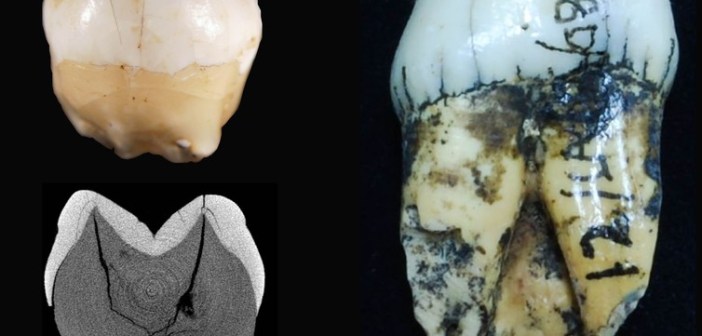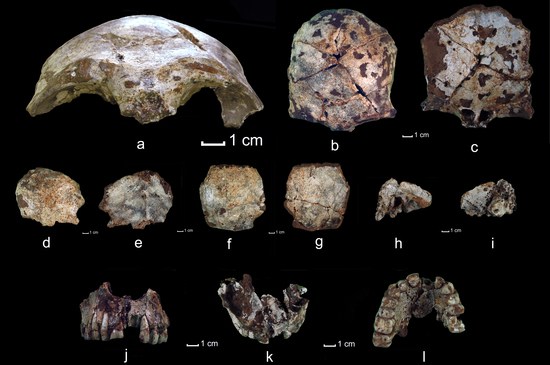New dating of Lida Ajer cave fossils places modern humans in SE Asia perhaps 73 000 years ago

Ancient teeth from a Sumatran archaeological site have pushed back the colonization of Southeast Asia by up to 20 000 years. The location of the cave site strongly suggests that the local human population was already well adapted to living in dense jungle environments by this period.
In 2009, paleoanthropologists uncovered a partial skull, jaw fragments and teeth at the Tam Pa Ling cave site in Laos. The fossils were subsequently identified as Homo sapiens and dated to between 46 000 and 63 000 years ago. This material represented the earliest evidence of modern humans in mainland Southeast Asia. That is, until now.
In the 19th century a maverick archaeological researcher, the Dutch paleoanthropologist Eugene Dubois, made several discoveries relating to early hominins in Southeast Asia, one of these was the discovery of fossil hominin teeth at the Lida Ajer cave site on Sumatra (1888). Unfortunately, the academic community did not fully appreciate Dubois’s research during his own lifetime and the teeth (like other finds Dubois had made) faded into history without significant impact on the human story. One legitimate complaint associated with Duboi’s research was the lack of due scientific process leading to uncertainties on the dating of his finds.

Dating to 46000 to 63 000 years ago, the human fossils found in Tam Pa Ling, Laos, are among the earliest Homo sapiens bones ever found in Southeast Asia. Credit: F. Demeter
The Lidar Ajer teeth were eventually identified as being those of modern humans, after detailed examination by Dirk Hooijer, the Dutch paleontologist. The dating of the fossils remained elusive, a mechanism to do this simply did not exist at the time. Not all researchers even agreed with Hooijer on the designation of the fossils as being those of a modern human, suspecting them might be those of late Homo erectus. There was certainly a significant population of Homo erectus living in the Indonesian region from as early as 1.8 million years ago up until perhaps as recently as 20 000 years ago.
New research published in the scientific journal Nature reveals that the Lida Ajer teeth are unequivocally those of anatomically modern human – identified by enamel–dentine junction morphology, enamel thickness and comparative morphology. The research scientists, led by Kira Westaway of Macquarie University in Australia, also accurately dated the teeth by means of combining multiple processes. Luminescence and uranium-series techniques were applied to the bone-bearing sediments and speleothems (mineral deposits from the cave), this was then coupled with uranium-series and electron spin resonance dating of the teeth.
We can now be quite certain that modern humans were living at cave sites on Sumatra between 73 and 63 thousand years ago. This finding follows the very recent revelation that modern humans were already living in on the northern end of the Australian continent by at least 65 – 80 thousand years ago (tools and ochre paints dated at the Madjedbebe rock shelter). The combining of these two discoveries radically revises the story of the modern human colonization of the globe.

a, An enlargement of the fossil chamber in Fig. 1c (dashed box) demonstrating the stratigraphic relationships and locations of samples that were collected for U-series dating of the flowstones (rectangles) and soda straw (star), U-series and coupled U-series/ESR of the fossil teeth (hexagon), and red thermoluminescence (TL) and pIR-IRSL of the breccia matrix (circle). b, The four main areas of breccia in the cave depicted by photographs. Areas 1–4 correlate with the marked sampling areas in a, and the symbols refer to the dating techniques listed in the key. c, The breccia from area 1 showing the angular clasts and sandy clay matrix. d, The underlying flowstone from area 2 was sampled for U-series dating (LA-F3). e, The calcite column from area 3 was sampled for U-series dating (LA-F2). f, The overlying flowstone from area 4 was sampled for U-series dating (LA-F1). Credit Westaway et al. 2017 – Nature Journal
The discovery of these teeth in what was dense rain forest territory also offers the earliest evidence of modern humans as being jungle adapted. The skills required to survive in the hostile deep jungles is generally understood to have taken considerable time to acquire, most models of early humans place them in open grassland areas. Additional research will be required to understand what forces drove these people into the difficult rain forest environments, and how early this began to occur.
One thing that can certainly be concluded at this stage in the investigation is that any migration beginning on the Africa plains somewhere between 70 – 60 thousand years ago is unsatisfactory as the explanation for modern humans living on the coasts of northern Australia over 65 thousand years ago, and other groups being well adapted to deep jungle life on Sumatra over 63 000 years ago.
By Bruce R. Fenton, AncientNews.net
Sources:
An early modern human presence in Sumatra 73,000–63,000 years ago – Nature
The Oldest Human Fossils in Southeast Asia? – Smithsonian Magazine
Old teeth from a rediscovered cave show humans were in Indonesia more than 63,000 years ago – The Conversation
Fossils rewrite story of human settlement in southeast Asia – Cosmos Magazine
Aboriginal Australian Artefacts up to 80,000 years old uncovered at the Madjedbebe rock shelter – Ancient News
Featured image: Lida Ajer modern human tooth (left top) with its corresponding scanned image (left bottom) compared to an orangutan tooth (right). Credit: Tanya Smith and Rokus Awe Due, author provided

Commenting rules and guidelines
We value the thoughts and opinions of our readers and welcome healthy discussions on our website. In order to maintain a respectful and positive community, we ask that all commenters follow these rules.